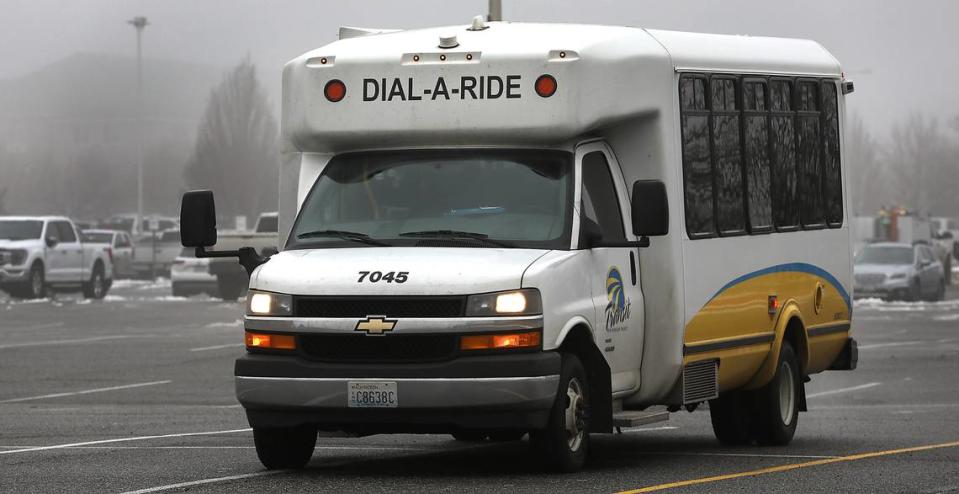
After a failed push to reduce the sales tax collection of the Tri-Cities’ regional transit agency, one county is now discussing breaking away entirely.
It’s a decision that could have massive social and economic consequences for the entire region, so the Herald decided to fact check some of the most common questions we hear from readers.
During Ben Franklin Transit’s April meeting, which focused on the potential sales tax cut, staff and board members got into a contentious debate over cost cutting.
Community members are concerned that some members of the board who have been pushing for the cuts are using misconceptions to justify it.
The meeting was marked by arguments among the board and angry responses from riders.
In one of the biggest rows of the evening, board members and staff had to push back at the idea of empty buses or only partially full buses costing the transit agency more, pointing out that people don’t ride buses end to end. They get on and off along the way, with some stops seeing more use than others.
The bus will fill up and continue on its route regardless of whether there are two or 20 people aboard and the cost doesn’t change, which is what makes buses more efficient than on-demand ride services.
Are buses too empty?
While you might see only a few people on the bus at a time, that’s not a good metric for measuring ridership. Ten people could have disembarked two stops earlier at the library or a grocery store. Luckily, the transit agency tracks those numbers.
Last year Ben Franklin Transit had 2.45 million fixed-route boardings, their highest since 2019. Across all services they provided nearly 3.2 million rides.
The transit agency has more than 400 vehicles serving 1,000 bus stops across the Tri-Cities, as well as providing door-to-door services for disabled riders and vanpools to large workplaces like the Hanford site.
In October 2023, the transit service hit a peak of nearly 315,000 fixed-route rides for the month, or more than 8,300 per day. Peak hours, such as morning and evening commutes see more than 1,000 riders at a time. They maintain 52 buses in maximum service to transport all those people.
On average BFT also provides more than 600 Dial-A-Ride trips per day.
Kirk Williamson, a retired member of the Community Health Needs Assessment/Improvements Steering Committee told the Tri-City Herald that cutting the sales tax would have a very small benefit for most taxpayers, but would have real impacts on the people who rely on the bus system.
“I think what’s important is the counter argument that the people who most need public transportation are the people they pretend to be trying to help by cutting the tax,” Williamson said.
“It’s people who had to leave their car at a mechanic and need to get home or to work …, I think there are good reasons people ride transit. I also think this isn’t the best bus system in the world to be a customer of.”
Williamson said BFT’s board should look at how they can improve services, rather than cut them.
At the heart of the board’s debate is whether Ben Franklin Transit has amassed a massive reserve of taxpayer money and what to do about it.
With board members regularly accusing each other of making incorrect statements about the transit service and its finances, it’s become even more difficult for the public to make an honest assessment about how their tax dollars are being spent.

Does BFT have a huge surplus?
This year Ben Franklin Transit set a $63 million budget. That’s $4 million over their 2023 budget, which actually ended the year more than $10 million under budget.
Like the cities and counties that BFT’s board members are elected to represent, the budget for the agency has grown significantly over the past decade. It’s a trend that city and county governments across the state are grappling with.
Costs have gone up across the board for people, parts, equipment and vehicles. Then these growing costs were accelerated by logistic issues caused by the COVID-19 pandemic.
There are a few reasons for these increasing revenues, such as rising tax collection due to increased retails sales, state carbon tax funding, pandemic era funding — almost $15 million for BFT’s 2024 budget -that had to be spent within a certain time frame and increasing property tax collections for cities and counties. Rising costs create the need to spend those funds.
While BFT’s budget was just under $60 million last year, the transit agency found enough savings to get their actual spending down to $48 million. That’s only part of how the agency has been able to accrue a large reserve.
BFT has $26.4 million obligated for capital projects and vehicle purchases. That means contracts have already been signed or the money has been earmarked for specific projects.
As the board members know from their experience managing fleets for law enforcement and fire departments, that money is typically set aside when a vehicle is ordered and paid out when it’s delivered. That can be a multiyear process with large, complex vehicles like buses and fire trucks. If they don’t lock in the deal up front, the costs can rise significantly.
With land purchases and building construction, they set aside money now to pay for the construction over the course of several years. In BFT’s case, there are millions of dollars in matching funds earmarked for certain projects that have yet to be completed or even approved.
One example is a $5 million grant to help build a park-and-ride lot in west Pasco. The transit board needs to give the agency direction on what land to buy for that project, but board members have concerns over land costs so no decision has been made.
The transit agency also keeps certain operating reserves on hand to help sustain them in case of economic downturn, emergency or disaster. That reserve pool totals $34.2 million.
It’s a requirement set not by Washington state or federal government, but by policies adopted by the Ben Franklin Transit board. Those reserves are broken down into categories for operations, capital, fleet replacement and fuel reserves.
Most of the remainder of their surplus is from cost savings the board directed former General Manager Rachelle Glazier to find. The bulk of the savings can be attributed to not filling open positions as drivers retired or left because ridership was down for several years as a result of the pandemic.
For example, Glazier found $7 million in savings for fixed-route expenses and $5 million for Dial-A-Ride just last year. Between savings and higher than expected revenues, largely due to grants, they had a $19.2 million surplus in 2023 and $7.6 million the year before.
That savings comes with a toll on its staff, say some drivers and their union. They believe the board has repeatedly taken aim at drivers who say they must call out sick or take medical leave to recuperate from the workload.
BFT’s union says that’s because as ridership returns to pre-pandemic levels, the transit agency’s decision not to fill positions leaves drivers forced to take on unsustainable levels of overtime, sometimes working weeks without a day off.
Are buses really cheaper?
At the last BFT board meeting, transit staff explained that just using smaller buses was less cost efficient, because they’d need to be repaired and replaced more often. They don’t last nearly as long and on many routes it would require drivers to swap out ahead of peak times throughout the day, such as morning and evening commutes and when students are leaving school.
Some transit board members have asked whether it would it be cheaper to privatize or use services like Uber.
Ben Franklin Transit already uses an on-demand service called Via to supplement its fleet and their own data shows it isn’t more cost efficient.
They recently expanded their contract with Via to help with overflow Dial-A-Ride calls. However, the transit agency’s financial reports are clear that standard fixed-route buses and vanpools are much cheaper to operate.

While cost of operation differs by vehicle type and trip distance, making smaller vehicles more efficient by the mile, that is offset when more riders are able to board.
Via Costs
-
Per Boarding – $22.78
Fixed-Route Costs
-
Per Boarding – $11.23
Vanpool Costs
-
Per Boarding $7.19
Some board members have pointed to cost per mile or hour as reasons to switch from buses to Uber-type services, but that metric lacks context in a system designed to move thousands of people per day.
The contract update BFT recently approved for Via to take on overflow Dial-A-Ride calls was structured to bill at a lower dollar per hour rate than running a full-sized bus, but it quickly becomes less efficient as the mini-vans are capable of moving much fewer people than the bus. That’s why Via’s cost per boarding is nearly twice as much.
Cost per boardings for Dial-A-Ride are much higher, because they are focused on helping disabled riders and are subject to far more federal regulations.
Via is also the only service area where BFT didn’t come in under budget last year. Despite picking up about 60% of Via’s budgeted riders, they overran costs which were forecast at $13.54 per boarding.
The transit agency had budgeted $2.75 million for 205,000 Via boardings. They ended up paying $2.9 million for 127,000 boardings.
The fixed-route buses managed 2.45 million boardings at a cost of $27.5 million, which was even more efficient than the 2.1 million that had been forecast at a cost of $33.6 million.
Fixed-route buses also cost the same to operate no matter what. The transit agency does occasionally adjust routes that aren’t seeing much use, but as a public service their role is to ensure reliable transportation so that riders know when they need to leave to get to medical appointments or to work.
A fixed schedule also creates a reliable time period parents can rely on for a bus to arrive. Almost one-third of all BFT rides last year were students.
Dori Luzzo Gilmour is the vice chair of BFT’s Citizen Advisory Committee. She told the Herald that she’s at a loss as to how board members can look at the same data that the committee does and come to wildly different conclusions about the needs of the Tri-Citians. She’s especially concerned about Franklin County commissioners discussing breaking up the transit system.
“Pasco is trying to grow their downtown, and put downtown on the map, is this what business owners want? I don’t think so,” she said. “The board directs staff, that’s what they do. They’ve been told to make these plans and now (Franklin County Commissioner Clint) Didier is saying, ‘Oh they’re wasting their money.’”
Luzzo said the land donated by Amazon for a bus stop near its new warehouses is a prime example of how to grow transit ridership for both underserved areas and businesses. She also points out that the youth riders will turn into adult riders, making serving students a smart long-term investment for the agency.
EMEA Tribune is not involved in this news article, it is taken from our partners and or from the News Agencies. Copyright and Credit go to the News Agencies, email [email protected] Follow our WhatsApp verified Channel









